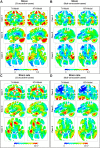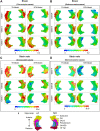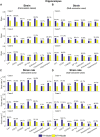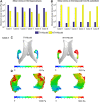The Presence of the Temporal Horn Exacerbates the Vulnerability of Hippocampus During Head Impacts
- PMID: 35392406
- PMCID: PMC8980591
- DOI: 10.3389/fbioe.2022.754344
The Presence of the Temporal Horn Exacerbates the Vulnerability of Hippocampus During Head Impacts
Abstract
Hippocampal injury is common in traumatic brain injury (TBI) patients, but the underlying pathogenesis remains elusive. In this study, we hypothesize that the presence of the adjacent fluid-containing temporal horn exacerbates the biomechanical vulnerability of the hippocampus. Two finite element models of the human head were used to investigate this hypothesis, one with and one without the temporal horn, and both including a detailed hippocampal subfield delineation. A fluid-structure interaction coupling approach was used to simulate the brain-ventricle interface, in which the intraventricular cerebrospinal fluid was represented by an arbitrary Lagrangian-Eulerian multi-material formation to account for its fluid behavior. By comparing the response of these two models under identical loadings, the model that included the temporal horn predicted increased magnitudes of strain and strain rate in the hippocampus with respect to its counterpart without the temporal horn. This specifically affected cornu ammonis (CA) 1 (CA1), CA2/3, hippocampal tail, subiculum, and the adjacent amygdala and ventral diencephalon. These computational results suggest that the presence of the temporal horn exacerbate the vulnerability of the hippocampus, highlighting the mechanobiological dependency of the hippocampus on the temporal horn.
Keywords: brain-ventricle interface; finite element analysis; fluid-structure interaction; hippocampal injury; temporal horn; traumatic brain injury.
Copyright © 2022 Zhou, Li, Domel, Dennis, Georgiadis, Liu, Raymond, Grant, Kleiven, Camarillo and Zeineh.
Conflict of interest statement
The authors declare that the research was conducted in the absence of any commercial or financial relationships that could be construed as a potential conflict of interest.
Figures






Similar articles
-
Hippocampal volume in normal aging and traumatic brain injury.AJNR Am J Neuroradiol. 1997 Jan;18(1):11-23. AJNR Am J Neuroradiol. 1997. PMID: 9010515 Free PMC article.
-
Volumetric analysis of hippocampal subregions and subfields in left and right semantic dementia.Brain Commun. 2024 Mar 25;6(2):fcae097. doi: 10.1093/braincomms/fcae097. eCollection 2024. Brain Commun. 2024. PMID: 38572268 Free PMC article.
-
Comparison of a fixed-grid and arbitrary Lagrangian-Eulerian methods on modelling fluid-structure interaction of the aortic valve.Proc Inst Mech Eng H. 2019 May;233(5):544-553. doi: 10.1177/0954411919837568. Epub 2019 Mar 29. Proc Inst Mech Eng H. 2019. PMID: 30922162
-
Psychosocial factors and hippocampal subfields: The Medea-7T study.Hum Brain Mapp. 2023 Apr 1;44(5):1964-1984. doi: 10.1002/hbm.26185. Epub 2022 Dec 30. Hum Brain Mapp. 2023. PMID: 36583397 Free PMC article.
-
Ammon's Horn 2 (CA2) of the Hippocampus: A Long-Known Region with a New Potential Role in Neurodegeneration.Neuroscientist. 2019 Apr;25(2):167-180. doi: 10.1177/1073858418778747. Epub 2018 Jun 5. Neuroscientist. 2019. PMID: 29865938 Review.
Cited by
-
Altered lateralization of the cingulum in deployment-related traumatic brain injury: An ENIGMA military-relevant brain injury study.Hum Brain Mapp. 2023 Apr 1;44(5):1888-1900. doi: 10.1002/hbm.26179. Epub 2022 Dec 30. Hum Brain Mapp. 2023. PMID: 36583562 Free PMC article.
-
A Spatial Interpolation Approach to Assign Magnetic Resonance Imaging-Derived Material Properties for Finite Element Models of Adeno-Associated Virus Infusion Into a Recurrent Brain Tumor.J Biomech Eng. 2024 Oct 1;146(10):101001. doi: 10.1115/1.4064966. J Biomech Eng. 2024. PMID: 38581376
-
Multi-modal MRI of hippocampal morphometry and connectivity after pediatric severe TBI.Brain Imaging Behav. 2024 Feb;18(1):159-170. doi: 10.1007/s11682-023-00818-x. Epub 2023 Nov 13. Brain Imaging Behav. 2024. PMID: 37955810 Free PMC article.
-
Computational Modelling of Protected and Unprotected Head Impacts in Rugby.Bioengineering (Basel). 2025 Mar 31;12(4):361. doi: 10.3390/bioengineering12040361. Bioengineering (Basel). 2025. PMID: 40281722 Free PMC article.
-
Surface-based versus voxel-based finite element head models: comparative analyses of strain responses.Biomech Model Mechanobiol. 2025 Jun;24(3):845-864. doi: 10.1007/s10237-025-01940-z. Epub 2025 Mar 11. Biomech Model Mechanobiol. 2025. PMID: 40067579 Free PMC article.
References
-
- Amaral D., Andersen P., O'keefe J., Morris R. (2007). The hippocampus Book. Oxford, United Kingdom: Oxford University Press.
-
- Baldwin S. A., Gibson T., Callihan C. T., Sullivan P. G., Palmer E., Scheff S. W. (1997). Neuronal Cell Loss in the CA3 Subfield of the hippocampus Following Cortical Contusion Utilizing the Optical Disector Method for Cell Counting. J. Neurotrauma 14, 385–398. 10.1089/neu.1997.14.385 - DOI - PubMed
LinkOut - more resources
Full Text Sources
Miscellaneous

